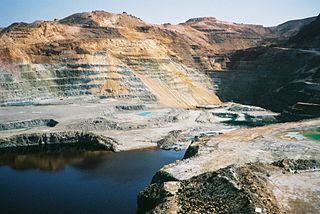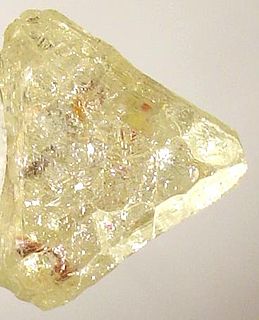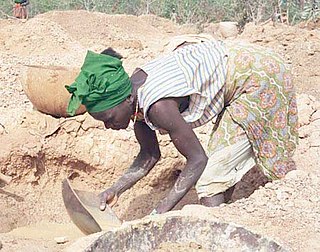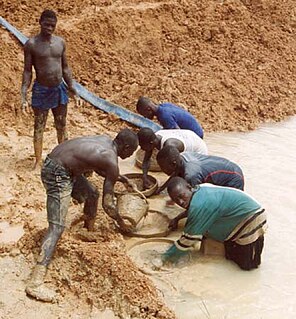 W
WThe Mining industry of Cyprus is synonymous with copper extraction which began around 4,000 BC. Copper dominates the mining sector along with mining of iron pyrite, gold, chromites and asbestos fibers, bentonite, cement, and also petroleum. Though at one time, copper was a mainstay of the economy, as of 2012, the mining sector does not contribute in a significant way to the GNP.
 W
WMining in Egypt has had a long histories that goes back to predynastic times. Egypt has substantial mineral resources, including 48 million tons of tantalite, 50 million tons of coal, and an estimated 6.7 million ounces of gold in the Eastern Desert. The total real value of minerals mined was about £E102 million (US$18.7 million) in 1986, up from £E60 million (US$11 million) in 1981. The chief minerals in terms of volume output were iron ore, phosphates, and salt. The quantities produced in 1986 were estimated at 2,048, 1,310, and 1,233 tons, respectively, compared with 2,139, 691, and 883 tons in 1981. In addition, minor amounts of asbestos (313 tons) and quartz (19 tons) were mined in 1986. Preliminary exploration in Sinai indicated the presence of zinc, tin, lead, and copper deposits. Private sector exploration and exploitation activities so far have been limited. Only recently, AngloGold Ashanti with its joint Venture Partner Thani Dubai and a Canadian listed exploration company, Alexander Nubia International have been undertaking exploration in Egypt's Eastern Desert with some success. Centamin Ltd., a mineral exploration company founded in Australia, started a massive mining project in Sukari Hill.
 W
WThe mining industry of Eswatini vests with the Ngwenyama who authorizes mineral rights after due consultation with the Minerals Committee, which he appoints. Fiscal contribution from mining operations to Eswatini’s GDP is 2% and also accounts for 2% of export earnings.
 W
WThe Mining industry of Ghana accounts for 5% of the country's GDP and minerals make up 37% of total exports, of which gold contributes over 90% of the total mineral exports. Thus, the main focus of Ghana's mining and minerals development industry remains focused on gold. Ghana is Africa's largest gold producer, producing 80.5 t in 2008. Ghana is also a major producer of bauxite, manganese and diamonds. Ghana has 23 large-scale mining companies producing gold, diamonds, bauxite and manganese, and, there are also over 300 registered small scale mining groups and 90 mine support service companies.
 W
WThe mining industry of Guinea was developed during colonial rule. The minerals extracted consisted of iron, gold, diamond, and bauxite. Guinea ranks first in the world in bauxite reserves and 6th in the extraction of high-grade bauxite, the aluminium ore. The mining industry and exports of mining products accounted for 17% of Guinea’s gross domestic product (GDP) in 2010. Mining accounts for over 50% of its exports. The country accounts for 94% of Africa’s mining production of bauxite. The large mineral reserve, which has mostly remained untapped, is of immense interest for international firms.
 W
WAlthough the subsoil of Ivory Coast contained many other minerals, none existed in commercially exploitable amounts, given the high costs of extraction. Mining contributed only 1 percent of GDP in 1986.
 W
WThe mining industry of Liberia has witnessed a revival after the civil war which ended in 2003. Gold, diamonds, and iron ore form the core minerals of the mining sector with a new Mineral Development Policy and Mining Code being put in place to attract foreign investments. In 2013, the mineral sector accounted for 11% of GDP in the country and the World Bank has projected a further increase in the sector by 2017.
 W
WThe mining industry of Libya does not contribute significantly to its economy. Mining resources are located in remote regions with limited accessibility. The fuel sector, including oil reserves and natural gas is the major revenue-generating industry.
 W
WThe mining industry of Madagascar is on a small scale, centred mainly around remote locations with large mineral deposits. Mining potential is noted in industrial and metallic minerals, energy, precious and semi-precious stones, as well as ornamental stone. The mining sector was neglected by the government for decades prior to the mid 2000s. In 2013, the mining industry, a main source of foreign investment, was struggling due to "low metals prices and distrustful companies", attributed to a 2009 coup.
 W
WThe mining industry of Malawi, includes a number of gemstones and other minerals.
 W
WThe mining industry of Mali is dominated by gold extraction which has given it the ranking as the third largest in Africa. Artisanal miners play a large part in the mining of diamonds. The other minerals extracted are rock salt and semiprecious stones. Phosphates are mined in the Tilemsi Valley. In 2013, gold exports were of the order of 67.4 tonnes, nearly a 50% increase over the production in 2012 which is attributed mainly to the contribution of 20.7 tonnes made by artisanal mining. Gold, followed by cotton, is the top export item making a large contribution to the economy of the country.
 W
WThe mining industry of Morocco is important to the national economy. Morocco is the world's largest producer of phosphate, and contains about 75% of the world's estimated reserves. Mining contributed up to 35% of exports and 5% of GDP in 2011. Foreign investors have found the investment climate, the infrastructure, fiscal situation, and political stability very favorable to continue business in the country in this sector.
 W
WRomania ranks tenth in the world in terms of the diversity of minerals produced in the country. Around 60 different minerals are currently produced in Romania. The richest mineral deposits in the country are halite.
 W
WThe mining industry of Senegal is mainly centred on the production of phosphates and industrial limestone. Senegal is one of the leading producers of phosphates in the world, accounting for about 6% of exports in 2006, and deposits are of a particularly high quality. In the coastal region of the country, titanium-bearing minerals have been found and the reserve is estimated at 10 million tons. The mineral sector's exports accounts for 20% of total exports of the country and constitutes 20% of the GDP.
 W
WThe mining industry of Sierra Leone accounted for 4.5 percent of the country's GDP in 2007 and minerals made up 79 percent of total export revenue with diamonds accounting for 46 percent of export revenue in 2008. The main minerals mined in Sierra Leone are diamonds, rutile, bauxite, gold, iron and limonite.
 W
WMining in South Africa was once the main driving force behind the history and development of Africa's most advanced and richest economy. Large-scale and profitable mining started with the discovery of a diamond on the banks of the Orange River in 1867 by Erasmus Jacobs and the subsequent discovery and exploitation of the Kimberley pipes a few years later. Gold rushes to Pilgrim's Rest and Barberton were precursors to the biggest discovery of all, the Main Reef/Main Reef Leader on Gerhardus Oosthuizen's farm Langlaagte, Portion C, in 1886, the Witwatersrand Gold Rush and the subsequent rapid development of the gold field there, the biggest of them all.
 W
WThe mining industry of South Sudan started operating from the time South Sudan became a regional government of Sudan in 2005. Its inheritance was a well developed petroleum industry with an extensive network of pipelines passing through Sudan. However, contractual allotments in mining lacked any form of regulatory framework, resulting in the legislative assembly imposing a moratorium on mining licenses in November 2010. With independence in 2011, the petroleum industry was halted. Subsequent to this event, interest in mining non-fuel minerals has emerged and a new Mining Act has come into effect from December 2012.
 W
WThe mining industry of Sudan was mostly driven by extraction fuel minerals, with petroleum accounting for a substantial contribution to the country's economy, until the autonomous region of Southern Sudan became an independent country in July 2011. Gold, iron ore, and base metals are mined in the Hassai Gold Mine. Chromite is another important mineral extracted from the Ingessana Hills. Other minerals extracted are gypsum, salt, and cement. Phosphate is found in Mount Kuoun and Mount Lauro in eastern Nuba. Reserves of zinc, lead, aluminium, cobalt, nickel in the form of block sulfides, and uranium are also established. Large reserves of iron ore have been established.
 W
WTanzania is a land rich in minerals. Mining makes up more than 50% of the country's total exports, of which a large part comes from gold. The country has gold reserves of 45 million ounces, generating revenue of over a billion USD. Diamonds are also found in significant amounts. Since it was opened in 1940, the Williamson diamond mine has produced 19 million carats (3,800 kg) of diamonds. Gemstones, nickel, copper, uranium, kaolin, titanium, cobalt and platinum are also mined in Tanzania. Illegal mining and corruption are ongoing problems. In 2017, the government passed a series of bills aimed at increasing revenue from minerals after a scandal which caused the dismissal of the Minister for Energy and Minerals.
 W
WThe mining industry of Togo is centred mainly around the extraction of phosphate, ranking it 19th in world production. Other minerals extracted are diamond, gold, and limestone. More minerals identified but yet to be brought into production mode are manganese, bauxite, gypsum, iron ore, marble, rutile, and zinc. The mineral sector contributes 2.8% to the country's gross domestic product (GDP).
 W
WThe mining industry of Tunisia focuses mainly on phosphate products such as fertilizer, industrial minerals, iron ore, and salt. Mine ownership is limited to the Government of Tunisia, although operation by private entities is encouraged.
 W
WThe mining industry of Uganda, documented as early as the 1920s, witnessed a boom in the 1950s with a record 30 percent of the country's exports. It received a further boost when mining revenues increased by 48 percent between 1995 and 1997. However, the World Bank reported that the sector's contribution to gross domestic product (GDP) dropped from 6 percent during the 1970s to below 0.5 percent in 2010. Uganda's extractive industry activities have been identified by the Natural Resource Governance Institute as focused on "extraction of cobalt, gold, copper, iron ore, tungsten, steel, tin and other industrial products such as cement, diamonds, salt and vermiculite". Limestone is sold in local markets whereas gold, tin, and tungsten are major exports.
 W
WThe mining industry of Zimbabwe is administered by the Ministry of Mines and Mining Development, the Department of Geological Survey, the Department of Metallurgy, and the Mining promotion and Development Department. The country's main commodities include metallurgical-grade chromite, as well as asbestos, coal, copper, gold, nickel, and iron ore.